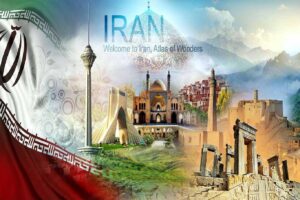Necropolis, also known as Naqsh-e Rostam, is an ancient historical site located near Persepolis in Iran. This historical site is a testament to the rich cultural heritage of the region and offers a fascinating glimpse into the ancient Persian civilization. With its magnificent rock-cut tombs and intricate reliefs, the Necropolis stands as a testament to the grandeur and architectural prowess of the Achaemenid and Sasanid Empires.
History of Necropolis

The construction of Necropolis dates back to the Achaemenid period, which spanned from the 6th to the 4th century BCE. The site was chosen as the final resting place for Persian kings and nobles. The tombs were carved into the towering cliffs, creating a striking and imposing sight.
read also: How to visit Persepolis
Architecture of Necropolis
The tombs at Necropolis are known for their impressive architectural design. The most prominent feature is the cross-shaped entrance that leads into the burial chamber. The façade of each tomb is adorned with intricate reliefs depicting scenes from Persian mythology and royal ceremonies.
One of the most famous tombs at Necropolis is the tomb of Darius the Great. This tomb stands out due to its sheer size and elaborate decoration. The relief carvings on the tomb depict Darius in various military and religious scenes, showcasing the power and authority of the Persian king.
The other significant part of the Necropolis dates back to the Sasanid era around 200 AD. Sasanid carvings depict the coronation of some of the most powerful kings and defeat scenes of Roman Emperors by Sasanid kings.
read also: about Pasargadae in Shiraz
Royal Portraits
The most famous carving at Naqsh-e Rostam is the investiture relief, depicting the investiture of Ardeshir I, the founder of the Sasanid Empire, by the Zoroastrian god Ahura Mazda. The king is shown receiving the ring of kingship.
Victory Scenes
Other carvings on the site depict Sasanid kings in victory scenes, often on horseback, symbolizing their military prowess and conquests. These reliefs celebrate their triumphs and the might of the empire.
Inscriptions
Many of the reliefs are accompanied by inscriptions in Middle Persian (Pahlavi) that provide historical and religious context. These inscriptions contribute to our understanding of the Sasanid dynasty’s ideology and achievements.
Zoroastrian Influence
The carvings also reflect the solid Zoroastrian influence during the Sasanid era, with many reliefs featuring religious symbols and imagery.
read also: visiting Cyrus the Great
Cultural Significance of Naqsh-e Rostam

The necropolis holds immense cultural significance for the people of Iran. It serves as a reminder of the glorious past of the Persian Empire and its influence on art, architecture, and civilization. The intricate carvings and reliefs found at the site offer valuable insights into the religious and cultural practices of the ancient Persians.
Moreover, Necropolis has been a subject of interest for archaeologists and historians alike. The tombs and their contents have provided valuable information about the lives of the ancient Persian rulers and their burial customs. The site continues to be a source of fascination for researchers seeking to uncover more about this ancient civilization.
Preservation Efforts
Over the years, efforts have been made to preserve and protect the tombs at Necropolis. The site has been designated as a UNESCO World Heritage Site and is regularly monitored to ensure its conservation. Measures such as controlled access and conservation work have been implemented to safeguard the historical significance of the site for future generations.
Tourism
Necropolis attracts tourists from all over the world who are captivated by its historical and architectural wonders. Visitors have the opportunity to explore the ancient tombs, marvel at the intricate reliefs, and soak in the rich history of the Persian Empire. The site is easily accessible from nearby cities, making it a popular destination for both local and international travelers.
Take part in our guided tours to the Necropolis, providing you a nice visit with a deeper understanding of the Necropolis’s history and architecture.
Visit the Necropolis
Necropolis, or Naqsh-e Rostam, is a remarkable testament to the ancient Persian civilization. Its rock-cut tombs and intricate reliefs showcase the architectural prowess and cultural richness of the Achaemenid Empire. As a UNESCO World Heritage Site, Necropolis continues to captivate visitors from around the world, offering a unique glimpse into the past and preserving the legacy of the Persian Empire.
Let us know your ideas and comments about Necropolis in the comment box below, we will be happy to hear from you!























